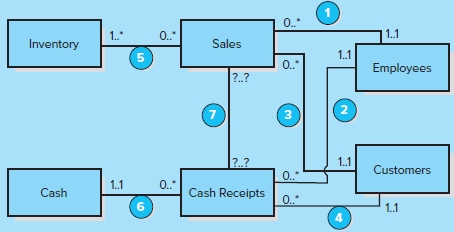1. Which of the following is not an activity within the sales and collection process? a. Selling...
Question:
a. Selling products and services
b. Billing customers
c. Managing inventory
d. Recording payments from customers
e. All of the above are sales and collection activities.
2. The sales and collection process is the point of contact between the firm and which set of external business partners?
a. Investors
b. Customers
c. Employees
d. Vendors
e. All of the above
3. Which of the following sales and collection process activities can result in the creation of an account receivable?
a. Receiving a sales order from a customer
b. Shipping ordered products to the customer
c. Billing the customer
d. Recording payment from the customer
e. None of the above
4. Which of the following describes message flows between pools? LO 5-2
a. Orchestrations
b. Sequence flows
c. Choreography
d. Intermediate events
e. None of the above
5. Which of the following statements is true?
a. Each pool must have a start event.
b. Sequence flows are shown by arrows with a solid line.
c. Message flows are shown by arrows with a solid line.
d. Each pool must have more than one swimlane.
e. Both a and b are true.
6. Which of the following is not a purpose of a sub-process in BPMN?
a. Reducing complexity
b. Presenting higher-level process descriptions
c. Creating alternative activities
d. Developing a reusable model
e. All of the above are purposes of sub-processes in BPMN.
7. What is the purpose of an intermediate error event?
a. Indicates a change in flow due to a process exception
b. Indicates the end of a process
c. Indicates the start of a collapsed sub-process
d. Describes the activities that will occur when there is not an error
e. None of the above
8. Which of the following is an example of a business rule implementing access controls?
a. The warehouse containing inventory must be locked when the inventory manager is
not present.
b. User€™s recording collections cannot modify sales records.
c. The computer system shall generate an audit trail.
d. Internal auditors shall be used.
e. Both a and b are business rules implementing access controls.
9. Which of the following is not part of the REA framework?
a. Agents
b. Type images
c. Resources
d. Events
e. All of the above are part of the REA framework.
10. How do you implement a one-to-many relationship in a relational database?
a. Post a foreign key.
b. Create a new table.
c. Combine two fields to create a primary key.
d. Create an association.
e. None of the above
Step by Step Answer:

Accounting Information Systems
ISBN: 978-1260153156
2nd edition
Authors: Vernon Richardson, Chengyee Chang, Rod Smith





